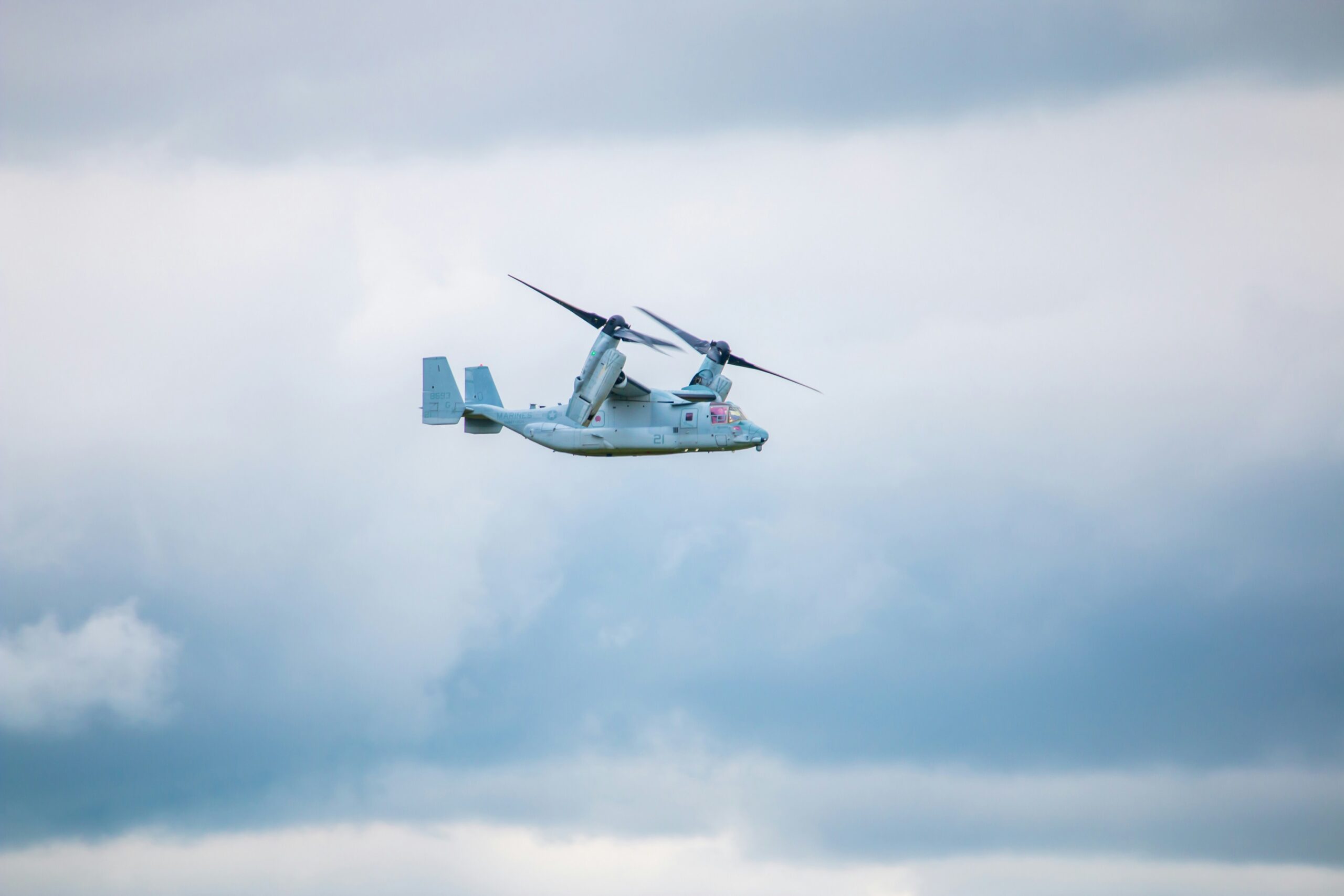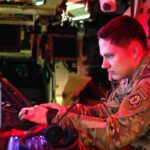Design work on the AE family started back in the 1980s. Teams wanted high thrust packed in a lighter shell. They shaved mass, swapped alloys, then ran hot-cycle trials that cracked more than few casings along the way. Those hard lessons stuck. When Bell linked with Boeing on a tiltrotor frame, the AE 1107C—mil crews tag it T406—matched the wish list. Early bench runs showed clean fuel burn, though log sheets flagged some odd temp spikes that engineers ironed out week later.
First Flight Testing and Early Fixes
Prototype sorties over Texas ranch land proved the idea. Pilots pushed nacelles forward, locked rotor speed, felt the craft surge like a big prop plane. Rolling back to hover showed another side of the engine. It needed quick torque catch, no lag. One crew noted slight rpm dip near 40-degree nacelle angle; a fast software patch cleared that by Friday. Certification wrapped by late ’90s, and pre-production Ospreys rolled off lines soon after.
Inside the V-22 Engine: Core Features of the AE 1107C
- The 14-stage axial compressor squeezes intake air
- Two-stage gas-generator turbine drives the core flow
- Two-stage power turbine turns that energy to rotors
- Six rows with variable vanes trim airflow on demand
- Dual FADEC units juggle fuel, track temps
Performance details match official Rolls-Royce specs, which confirm modular design and thermal protections. Mechanics favor the modular frame. They swap compressor modules without yanking full lump, saving days at sea where cranes sit scarce. An effusion-cooled combustor spreads heat, stops hotspots that scorch liner metal. A sealed oil loop holds pressure even when the bird banks sharp or slams deck at dusk.
First Major Service Record and Maintainer Impact – V-22 Engine Hits 500 Hours in Harsh Use
On 15 Aug 2023 an MV-22B logged 500 hours on one untouched engine. Only basic filter swaps and borescope peeks were needed. Ceramic coatings shrugged off Gulf salt corrosion, cuts on parts count looked clear in the ledger. The record slid into routine flight books, still word raced across squadrons. For maintainers it meant fewer surprise pulls during next float.
Osprey Mission Spread
Tiltrotors reshape task lists without asking for long runways:
- Troop lifts—move 24 Marines from beach to ridge in one hop
- Cargo hauls—sling pallets onto destroyer decks while seas pitch hard
- Rescue calls—extract wounded out of tight alleys after dusk
- Special inserts—low-profile flights through thin mountain air
All variants lean on the same twin engines. Crews cruise near 270 knots once nacelles swing forward, then slow to hover above dust thick as soup. The flip punishes hardware, yet the T406 keeps pulling.
Rolling Block Upgrades: 2022–2024 Improvements to T406
Rolls-Royce rolled in steady tweaks, nothing flash:
- Higher-temp turbine blades, nickel blend with rare-earth sprinkles
- FADEC code rewrite for smoother throttle steps
- Oil reroutes moving hot bends away from seals
Cold-start drills in Alaska hit minus-30 °C; engines lit first push. Yuma tests baked at 46 °C; power stayed inside limits. Vibe numbers fell from 0.43 ips to about 0.3 at max torque. Feedback loops between squadron techs and factory engineers kept tune-ups brisk.
Sensors, Snap Repairs, and Predictive Maintenance Gains
Later block kits added more probes—pressure taps, gyro bolts, thermo rings. Data streams land straight on cockpit pages. If a module drifts, a yellow band flashes, prompting fast checks. Ground techs pull logs on rugged tablets, flag parts before coffee cools. Three test squadrons saw downtime drop roughly 18 percent after the upgrade.
Sustainment Framework and Tactical Readiness
Bell, Boeing, and Rolls-Royce meet every quarter with service reps. Those syncs resemble Lockheed’s broader move toward Europe to tackle complex bottlenecks. Overseas Osprey users tap the same chain for spares and on-site advice. Some send technicians to U.S. schools; others host mobile teams that fly in with kits packed under cargo seats. The flexible route trims cost and keeps readiness high.
2023 Contract Boost
The Pentagon extended sustainment support last year, worth several hundred million. Key planks:
- Depot rebuilds at two overhaul shops
- Forward field reps for surge ops or mishap recovery
- Tight configuration tracking so software stays even fleetwide
Commanders liked the traceability clause; one wrong patch can ground an entire line during cruise.
Adapting the AE1107C to Harsh Realities
Desert dust eats inlet blades fast. Crews fitted mesh screens and ran short purges. High-altitude stages over Andes ridges forced richer fuel mix for cleaner combustion. Torque jitters seen in 2022 traced back to loose sensor mounts, not core faults; new bolts fixed the run. The quick cycle from field note to factory solution shows maturity—raw logs, plain fixes, no marketing gloss.
New Material Trials
Lab rigs in Indianapolis spin ceramic matrix composite disks that shrug hotter gas than nickel parts. Engineers now look beyond the AE line, tracking innovations seen in recent orders for Eurofighter engines. Early coupons handled 500 cycles with minor pitting. Design leads stay cautious, still, the path looks promising.
Rotor Tweaks on Horizon
Bell concept teams sketch wider twist blades for future wing sets. Added lift at hover, less drag in cruise—those tweaks mirror lessons from early prototype testing. Any geometry change shifts engine torque map. Simulation crews already plot safe bands; initial results say T406 copes without major hardware swap. Big redesign sits years out, groundwork now saves headache later.
Tempo Keeps Rising
Marine, Navy, and Air Force units pull Ospreys for separate goals. Pacific patrols stretch miles; carrier groups need quick COD hops; SOCOM drills late nights. Forecasts show flight hours climbing 15 percent by 2027. Supply points already stock extra modules to dodge dry shelves.
Growing Global Interest
Several allies watched deck demos at last Farnborough show. They liked the compact landing footprint, quizzed teams on spare stocks, and studied log charts. Common engine pool lowers entry costs. Talk of two letters of intent floats around but stays private for now.
Cleaner Burn Goals
Emission caps tighten slowly. Rolls-Royce tested 50 percent SAF blends, power stayed level, exhaust soot dipped near 16 percent per spectrographs. Greener burn also cuts thermal trails, a quiet bonus for low-profile moves.
Mid-2023 Snags and Fixes
Extended hover near amphib decks spiked turbine inlet temps by 25 °C. Inspectors found cooling ports partly clogged by salt crust. Cleaning cycles shortened, jet holes widened, temps returned to green. Oil leaks traced to slam landings on dusty pads; reinforced couplings stopped seepage. Tech bulletins rolled out fast, downtime stayed low.
Tactical Shift Sparked by the Engine
Pre-tiltrotor, planners chose between chopper reach and prop speed. The T406 enabled both. Units skip risky convoy roads and slot gear straight onto remote FOBs. Carrier wings move mail and parts in hours, not days. The engine’s mix of lift and thrust shapes new playbooks.
Deck Handling Perks
Quick spool from idle to climb needs under six seconds. On tight decks that window matters when slots juggle between jets and rotorcraft. Reserve torque steadies hover in gusty crosswinds, giving pilots slim but vital margin. Early sag issues now gone after software trim and stiffer blades.
2025 and Beyond
Rolls-Royce eyes a tentative Block 4 set:
- Shaped turbine nozzle for smoother swirl
- Stronger main bearings, new alloy cages
- Expanded FADEC memory with secure cloud links
Early lab cycles hint at roughly eight-percent power lift at sea-level standard day. Extra push means heavier sling loads, faster climb on hot-high missions. Final numbers wait on flight tapes due next year.
Data Pipeline Overhaul
Upcoming FADEC bolts log packets to encrypted sat links while rotors fold. Squadron chiefs review health graphs the same evening, not next week. Tablet alerts if vibration plots cross thresholds, prompting on-spot checks. A single software line across Marine, Navy, Air Force jets clears messy version forks and trims support cost.
Training Hub Plan
A new simulator center opens late 2025. Motion domes run desert dust, Arctic fog, and deck spray views, each designed to stress thrust logic. Pilots learn fresh FADEC cues; maintainers practice remote diagnostics. Updates feed straight from factory laptops into the sim, shortening feedback loops.
Wider Block 4 Appeal
Search-and-rescue crews value planned horsepower gain. Heavier winch rigs or long-loiter fuel loads fit future sorties. Mountain units picture sling lifts to high valleys. A demo next spring will hoist twin six-ton pallets over Colorado peaks. Success likely drives more export talks.
Numbers at a Glance
- 500 engine hours on first record bird, no overhaul
- 18 percent downtime drop after sensor upgrade
- Vibration trimmed to 0.3 ips at max torque
- Over-temp events reduced to zero after port clean
Stats shift weekly, yet direction stays positive. Predictive analytics flag parts before break, keeping mission lines smooth.
Cost Perspective
Block kits demand budget upfront, but they shave unplanned pulls later. One squadron cut 2.4 million dollars in spare bills after Block 3. Figures vary by unit, still trend proves consistent: small tweaks cheaper than full re-engine.
Deck Crew View
An aviation machinist second class noted in daily log that torque sensor swaps now finish within a single duty block. Her downtime column once filled red; lately stays mostly green. Minor slip with a loose bolt flagged fast during post-flight cross-check—evidence of both human error and quick catch routines.
AE1107C Block 4 Trials and Data Integration – March 2025 Update
Block 4 ground trials wrapped high-speed spool tests last month. New nozzle held solid to 1,225 °C gas flow. Bearing cages showed no gall in 120-hour run. Retrofit kit aims for bolt-on fit, not full engine change. Software freeze targets Q4 2025, flight release early 2026 if paperwork lines move prompt.
The AE 1107C began as bold bet on blended flight modes. Decades later it owns real scars, fresh records, and stronger blocks in the works. A 500-hour streak under harsh field use proves core toughness. Pending upgrades add more muscle and smarter brains. Tiltrotor crews will lean heavy on that curve as missions push farther, hotter, and faster. Each new cycle writes another line in the story, powered by that same compact core spinning inside the big twin rotors. The platform now exceeds over a million flight hours, showing long-term endurance in real missions.
REFERENCE SOURCES:
- https://skybrary.aero/aircraft/v22
- https://www.af.mil/About-Us/Fact-Sheets/Display/Article/104531/cv-22-osprey/
- https://www.globalsecurity.org/military/systems/aircraft/systems/ae1107.htm
- https://www.rolls-royce.com/media/press-releases/2019/16-10-19-ae1107-engines-have-exceededmillion-engine-flight-hours.aspx
- https://www.flightglobal.com/rolls-royce-touts-high-hot-performance-of-upgraded-engine-for-v-22/114522.article
- https://www.americanmachinist.com/news/article/55246516/dod-awards-695m-for-v-22-engine-support-rolls-royce-corp
- https://en.wikipedia.org/wiki/Rolls-Royce_T406
- https://www.rolls-royce.com/products-and-services/defence/aerospace/rotary/ae-1107c.aspx#section-technology



